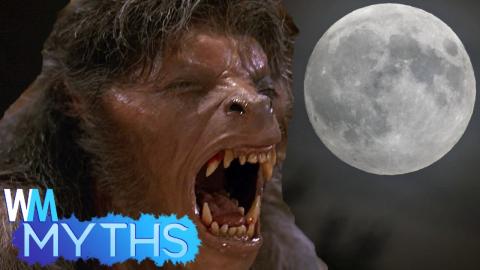Top 5 Myths About The Moon

Together… we shall travel the stars. Wait, we can't do that? Ugh… fine. Well, then let's just go explore that weird space rock that hangs out near our planet. Welcome to WatchMojo's Top 5 Myths. In today's instalment we're counting down the Top 5 Myths About the Moon.
#5: It Goes Around the Earth in a Day
Alright, so thanks to historical badasses Copernicus, Galileo Galilei, and, well, NASA, we can now say with certainty that the sun does NOT revolve around the earth. The moon on the other hand, does circle the globe. So, how long does it take? Well, considering you see it come and go every night, you’d be forgiven for saying, “Like, every 24 hours?”. But you’d be wrong, and not by a small margin. Depending on the method of measurement, the lunar orbit takes either 27.3 days (a sidereal month) or 29.5 days (a synodic month). The discrepancy stems from whether you use the sun or stars as your reference point. Technically, both are correct.
#4: A Blue Moon Is Actually Blue in Color
We know what you’re thinking: “Yeah WatchMojo, we know the moon doesn’t literally change color, it just LOOKS blue”. But here’s the thing: while a moon low on the horizon may sometimes appear orange due to atmospheric tricks of light, a “blue moon” just looks like a regular old full moon. . . you know, kind of a grayish-white orb. What actually makes a “blue” moon special is the fact that it is the 13th full moon in a calendar year, which typically has only 12. With this 13th moon showing up every 2 or 3 years, it would seriously mess up the fasting schedule for Lent, and so in Old English it was called “belewe”, which roughly translates to “traitorous”.
#3: It Has a Dark Side
Sadly, the only actual “Dark Side of The Moon” was released in 1973 by Pink Floyd. When we look at the moon, we can only see one side of it, that much is true. But the other side, which could more accurately be called the “far side of the moon”, still gets sun exposure.You see, while the world completes a rotation on its axis roughly every 24 hours, the moon only completes a full rotation in the same amount of time it takes to complete its orbit around the earth. As a result, we only ever see the same side of it, its face, while the sun shines on it over both the moon’s sides over the course of its orbit. Don’t be jealous, it’s the less interesting side.
#2: A Full Moon Causes Strange Behavior
Ever wondered where the word “lunatic” came from? Blame it on the moon. We’ve all heard someone say “Must be a full moon” when pointing out an excess of erratic or downright crazy behavior in humans and animals. The theory of “lunar effects” has a long history, dating back to Ancient Babylon. But if geocentrism has taught us anything, it’s that we shouldn’t put stock in a theory just because it’s been around a long time. So what does science have to say about it? Well, not much. In a 1985 study that evaluated the research of 37 other previous studies, scientists failed to find any correlation between lunar cycles and erratic behavior, accidents or temporary insanity. No werewolves either.
#1: The Moon Landing Was a Hoax
Alright conspiracy theorists, let’s do this. You’ve been denying the accomplishments of Mr. Neil Armstrong and Buzz Aldrin long enough. They went all the way into space and landed on that cratered rock, only to return home and have you question their integrity. For shame. There’s all kinds of proof, but one explanation should do: THEY DID NOT HAVE THE TECHNOLOGY TO FAKE IT ON VIDEO. Take the footage of the lunar rover from Apollo 16 kicking up dust, which was thoroughly analyzed in the early 21st century. According to researchers at the University of Colorado, the trajectory of the dust cloud could only have happened in the vacuum of space. CGI that accurate or convincing simply didn’t exist in 1972, when the Apollo 16 mission footage was filmed. Mic drop.
Sign in
to access this feature